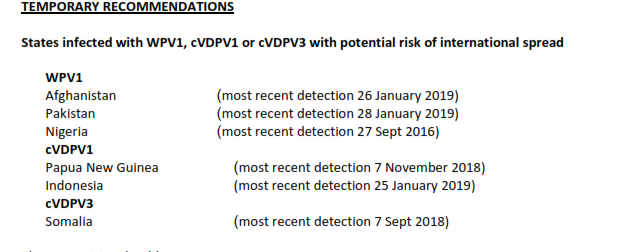Statement of the 20th IHR Emergency Committee regarding the international spread of polio virus – 19th February


Additional information
Wild polio virus transmission
Afghanistan and Pakistan
- Afghanistan and Pakistan being the only two countries where wild poliovirus transmission is continuing to be reported.
- An increase in WPV1 cases in 2018, with more cases in the two countries than in 2017. This trend appears to be continuing in 2019, with six cases already compared to two for the same period in 2018. Spread between the two countries has continued, after an earlier 10-month period of no international spread between the two neighbours.
- In Pakistan transmission continues to be widespread, as indicated by the number of positive environmental isolates in many areas of the country. The recent case in Lahore also indicated vulnerabilities still exist outside the high-risk corridors.
Nigeria
- It is now more than two years since the last WPV1 was detected in Nigeria, and four years since there has been any international spread of WPV1 from the country.
Vaccine derived poliovirus
There are now eight countries in four WHO Regions responding to outbreaks of cVDPV,
- Indonesia - new outbreak of cVDPV1 in Indonesia exemplifies the gaps in population immunity in many parts of the world considered polio free.
- Papua New Guinea continues to mount a very effective response, and the committee noted that both Indonesia and PNG had been pro-active in ensuring effective coordination on both sides of the border.
- Mozambique: new outbreak of cVDPV2 in Mozambique is a serious concern, as it may be linked to inadequate controls placed upon unused vials mOPV2 during the earlier event there in 2017. The committee noted that the case occurred close to the border with Malawi, prompting concern about the opportunity for international spread.
- Nigeria: The cVDPV2 outbreaks in Nigeria highlight the vulnerability to poliovirus infection in many parts of the country, with the virus spreading to areas not previously considered at high risk of polio, such as
- Kwara: Although no international spread of WPV1 has been observed from Nigeria since 2014, the recent cases of importation of cVDPV2 into Niger is concerning, given that cVDPVs have rarely spread across borders in the past. The committee was concerned by the lack of progress in controlling this outbreak, and the proximity of a recent case to the Republic of Benin. The committee noted the repeated importations from Nigeria into Niger indicates that while strong efforts had been made to respond to risks posed by high risk populations such as cattle herders and other nomads, IDP's and refugees, more needs to be done to prevent future international spread between Nigeria and Niger. Surveillance gaps in nearby vulnerable countries in the Lake Chad area raises concerns about missed transmission in these countries.
- Somalia and Kenya: The outbreak of cVDPV2 in Somalia and Kenya is another infrequent example of international spread
- DR Congo: Although there are indications that transmission may be slowing in DR Congo, the protracted duration of the outbreak, ongoing conflict, insecurity and population movements within and outside the country represent a significant risk of spread.
Conclusion: The risk of international spread of poliovirus remains a Public Health Emergency of International Concern (PHEIC) and recommended the extension of Temporary Recommendations for a further three months. The Committee considered the following factors in reaching this conclusion:
- Rising number of WPV1 cases
- Complacency
- Rising number of cVDPV outbreaks
- International spread of cVDPV
- Weak routine immunization
- Surveillance gaps
- Protracted outbreaks
- Lack of access
- Population movement

